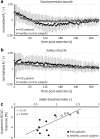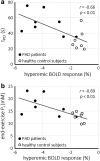Dynamic magnetic resonance measurements of calf muscle oxygenation and energy metabolism in peripheral artery disease
- PMID: 31218803
- PMCID: PMC6916546
- DOI: 10.1002/jmri.26841
Dynamic magnetic resonance measurements of calf muscle oxygenation and energy metabolism in peripheral artery disease
Abstract
Background: Clinical assessments of peripheral artery disease (PAD) severity are insensitive to pathophysiological changes in muscle tissue oxygenation and energy metabolism distal to the affected artery.
Purpose: To quantify the blood oxygenation level-dependent (BOLD) response and phosphocreatine (PCr) recovery kinetics on a clinical MR system during a single exercise-recovery session in PAD patients.
Study type: Case-control study.
Subjects: Fifteen Fontaine stage II patients, and 18 healthy control subjects FIELD STRENGTH/SEQUENCE: Interleaved dynamic multiecho gradient-echo 1 H T2 * mapping and adiabatic pulse-acquire 31 P-MR spectroscopy at 3T.
Assessment: Blood pressure in the arms and ankles were measured to determine the ankle-brachial index (ABI). Subjects performed a plantar flexion exercise-recovery protocol. The gastrocnemius and soleus muscle BOLD responses were characterized using the T2 * maps. High-energy phosphate metabolite concentrations were quantified by fitting the series of 31 P-MR spectra. The PCr recovery time constant (τPCr ) was derived as a measure of in vivo mitochondrial oxidative capacity.
Statistical tests: Comparisons between groups were performed using two-sided Mann-Whitney U-tests. Relations between variables were assessed by Pearson's r correlation coefficients.
Results: The amplitude of the functional hyperemic BOLD response in the gastrocnemius muscle was higher in PAD patients compared with healthy subjects (-3.8 ± 1.4% vs. -1.4 ± 0.3%; P < 0.001), and correlated with the ABI (r = 0.79; P < 0.001). PCr recovery was slower in PAD patients (τPCr = 52.0 ± 13.5 vs. 30.3 ± 9.7 sec; P < 0.0001), and correlated with the ABI (r = -0.64; P < 0.001). Moreover, τPCr correlated with the hyperemic BOLD response in the gastrocnemius muscle (r = -0.66; P < 0.01).
Data conclusion: MR readouts of calf muscle tissue oxygenation and high-energy phosphate metabolism were acquired essentially simultaneously during a single exercise-recovery session. A pronounced hypoxia-triggered vasodilation in PAD is associated with a reduced mitochondrial oxidative capacity.
Level of evidence: 2 Technical Efficacy: Stage 1 J. Magn. Reson. Imaging 2020;51:98-107.
Keywords: atherosclerosis; exercise stress; interleaved scanning; intermittent claudication; metabolic hyperemia; mitochondrial dysfunction.
© 2019 The Authors. Journal of Magnetic Resonance Imaging published by Wiley Periodicals, Inc. on behalf of International Society for Magnetic Resonance in Medicine.
Figures




References
-
- Bhatt DL, Steg PG, Ohman EM, et al. International prevalence, recognition, and treatment of cardiovascular risk factors in outpatients with atherothrombosis. JAMA 2006;295:180–189. - PubMed
-
- Fowkes FGR, Rudan D, Rudan I, et al. Comparison of global estimates of prevalence and risk factors for peripheral artery disease in 2000 and 2010: A systematic review and analysis. Lancet 2013;382:1329–1340. - PubMed
-
- Wennberg PW. Approach to the patient with peripheral arterial disease. Circulation 2013;128:2241–2250. - PubMed
-
- Aboyans V, Criqui MH, Abraham P, et al. Measurement and interpretation of the ankle‐brachial index. Circulation 2012;126:2890–2909. - PubMed
-
- de Graaff JC, Ubbink DT, Legemate DA, Tijssen JG, Jacobs MJH. Evaluation of toe pressure and transcutaneous oxygen measurements in management of chronic critical leg ischemia: A diagnostic randomized clinical trial. J Vasc Surg 2003;38:528–534. - PubMed
Publication types
MeSH terms
Substances
LinkOut - more resources
Full Text Sources
Other Literature Sources
Medical
Research Materials

